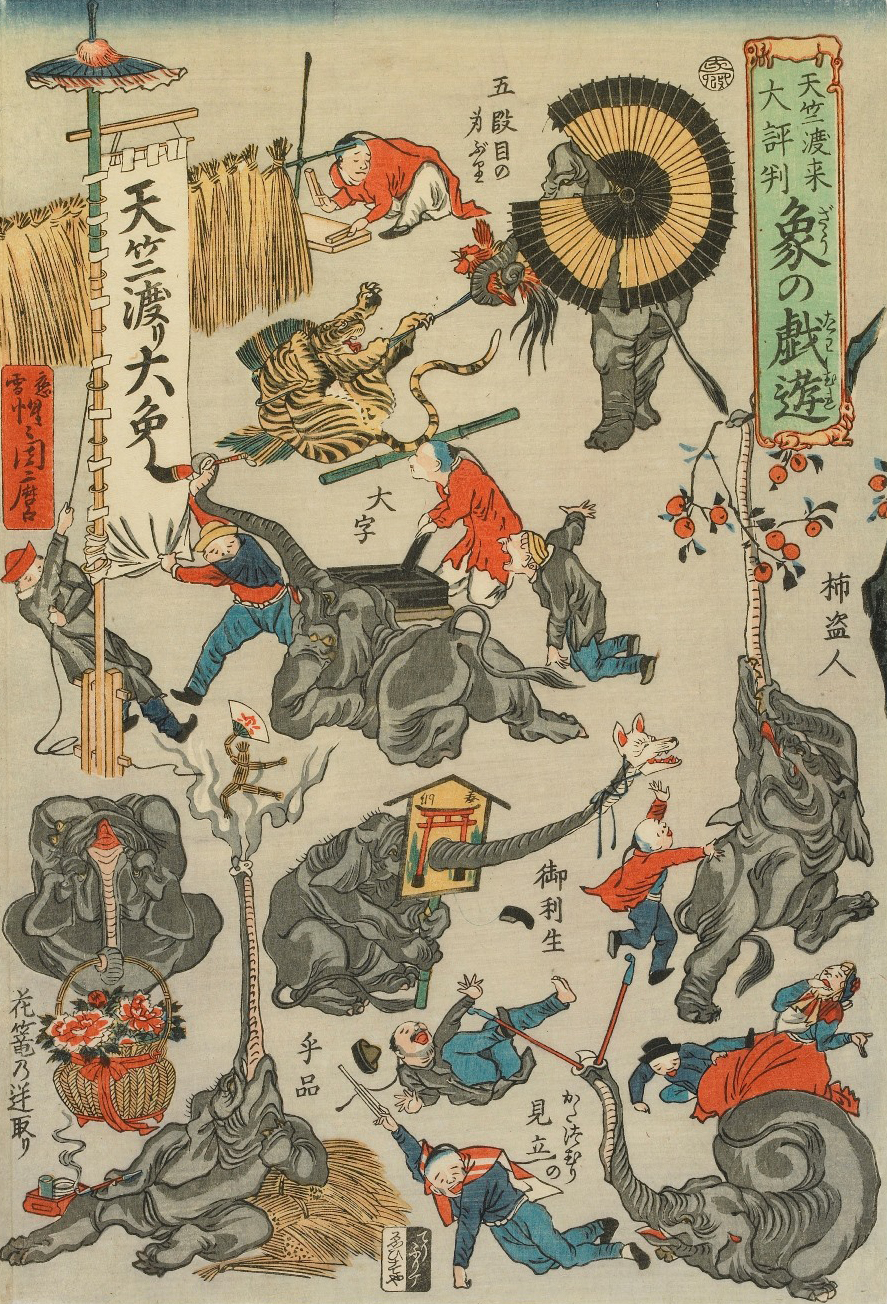Elephants and elephant products are in use for medical purpose in many countries across the Indian ocean. Stories about this animal were gathered and written by students. They are all part of a pedagogical project, funded by the National University of Singapore and the Université de Paris. The Bestiary site is a work-in-progress and a participatory educational tool, representing animals whose products or body parts are used to promote health and healing.

Tusks & Skin in India
A story by Resheena Shankar
Due to the significance of elephants in Indian culture, elephants are not used in traditional Indian medicine. (…) However, elephants are poached for their value in making products, such as ivory from tusks, and for their body parts to treat certain illnesses such as eczema in traditional Chinese medicine (TCM).
India has regarded the elephant as a majestic royal beast that symbolizes its culture for centuries. The elephant is also seen as a sacred animal and is considered to be the representation or the living incarnation of lord Ganesh, the elephant-headed Indian deity riding a mouse. Ganesh is the god of success and the destroyer of obstacles and prosperity.
Each part of the deity Ganesh represents a function, with his large ears representing a patient listener, and his small eyes invoking belief that they behold the future. His eyes are said to recognize the truth and see not from the physical, but through the spirit. His long and narrow trunk allows him to smell good and evil, and his big belly symbolizes its ability to digest all the good and evil in life. In Indian mythology, flying elephants are often depicted, and the white elephant Airavata is the most highly regarded. He has 4 tusks and 7 trunks, and is seen carrying the Hindu God Indra on his back. Airavata is also believed to possess the power of producing rain. These Hindu cultural beliefs have established the elephant as a symbol of divinity, royalty, peace, mental strength and power.
Over the years, people have worshipped and used elephants in several ways, such as in religious ceremonies and rituals in temples. This traditional practice continues in India until today. According to a World Animal Protection report, India is considered to be the “birthplace of taming elephants for the use of humans” (“Over 200 Elephants in India,” 2020).
Due to the significance of elephants in Indian culture, they are not used in traditional Indian medicine. In fact, there are many medicines and treatments for elephants in India, such as in Ayurvedic system of medicine. However, elephants are poached for their value in making products, such as ivory from tusks, and for their body parts to treat certain illnesses such as eczema in traditional Chinese medicine (TCM).
Value in Asian medicine
In the past, poachers mainly hunted male elephants for ivory as female elephants do not have tusks. However, poachers now target all elephants irrespective of gender and age because in TCM elephant parts are used to treat certain conditions. Specifically, elephants are poached for their skin, which is dried, ground and mixed with oils to treat eczema and other skin conditions such as eczema and acne among humans. Elephant skin is priced at approximately $110/kg and numerous black markets exist for the trade of elephant parts. Typically, poachers use darts, and metal and bamboo spears dipped in pesticides to kill the elephants, causing them to die a slow and painful death.
Although elephants are used in TCM to treat several illnesses, elephants can also transmit diseases to humans. Elephants are zoonoses carriers and are found to carry human tuberculosis (TB), which is a bacterial disease that is responsible for a global pandemic and is the leading infectious cause of human deaths worldwide. TB is potentially dangerous and can be transmitted through air, putting anyone at risk of infection. There have been many instances of infected elephants spreading TB to humans. To name a few, in Tennessee, an outbreak among 13 humans of which one had direct contact with infected animals was linked to TB infected elephants once used in the circus. Similarly, in 2013, an infected elephant transmitted TB to 8 employees in contact with the elephant at the Oregon Zoo in the US. Of the 8 employees, one of them developed pulmonary disease as well. Studies conducted revealed that circus elephants in particular are at risk of contracting TB due to exposure to infected humans or elephants caused by routine transport. Other possible reasons for this phenomenon could be the stress factors such as painful punishment, extreme confinement and poor nutrition in circuses.
Famous Elephants Imported from India at Play (Tenjiku torai dayhyoban zo no giyu)
Artist: Kawanabe Kyōsai 河鍋暁斎 (1831-1889). Edo period, 1862. Arthur M.Sacker Gallery

Elephant with mahout (Hampi, Karnataka, India 2017) © Leo Jalais
References
“Tuberculosis at the Circus”. (n.d.). Peta, (retrieved October 14, 2021).
Scigliano, E. (2017, November 29). “Asian Elephants Are Now Being Killed for Their Skin”. National Geographic.
“Over 200 elephants in India kept in severely inadequate conditions”. (2020, August 20). World animal protection, (retrieved October 29, 2021).
Elephant Pearls from Sri Lanka
A Story by Kavindu Chathurajeewa Senaviratne
Elephant pearls are worn by people as a cure for cancer, arthritis, childlessness, impotence, and joint pain. It is believed that wearing elephant pearls can bring you more than just healing powers.
Elephants of Sri Lanka have had a considerable importance in the cultures, histories, and religions as well as the royal traditions of Sri Lanka. The elephant has been described in many literary texts such as “Maha Wansaya” and “Thupa Wansaya”. Elephants have been used to symbolize royalty and dignity, which is why, only the aristocrats owned elephants in the ancient times. The kings were mentioned to have owned “Magul Atha” which means the ceremonial pet elephant. It is also rumored that in case of no heir for the throne, the ceremonial elephant was used to pick the next king. In such cases, the elephant is said to bend its knees in front of the next king. During the war against the Tamil king Elara, king Dutugamunu had used his ceremonial elephant as his war chariot and the two kings were rumored to have dueled whilst mounted on their respective ceremonial elephants.
The most widespread religion in Sri Lanka is Buddhism and Buddhism has used the elephant to symbolize certain divine aspects of Buddhist mythology. According to the mythology, Siddartha Gauthama’s mother was said to have been blessed by a white elephant, which implied that she had conceived something divine. The elephant appears many more times in mythologies, sometimes symbolizing anger and brute force and at other times standing in for regality or even calm. Elephants are used in the “Asala maha perahara” (Religious parade) at the Temple of the Tooth Relic in Kandy. They are decorated with colorful and illuminated drapery and they are tasked with carrying the sacred tooth relic of the Buddha.
Currently, Sri Lankan elephants are on the endangered list of wild animals. Furthermore, there have been growing instances of human and elephant clashes. The local government and other private welfare organizations are putting efforts to conserve elephant populations. Since the wild elephant population is fragmented, there have been many efforts to repopulate elephant colonies by the wildlife department. Pinnawala Elephant conservatorium is a very popular elephant sanctuary which also happens to be a popular tourist destination.
Value in Asian medicine
Elephants in Sri Lanka are famous and iconic for their tusks. During death ceremonies, two elephant tusks are kept on either side of a dead person’s body to honor the dead. Elephant “pearls” hold a special place in Sri Lankan spiritual healing communities. Traditional medicine and healing are deeply embedded in Sri Lankan culture. Some people believe that ailments are caused by paranormal factors such as gods or lesser spirits. In some other cases, illnesses are believed to be caused by faulty chakra in the body or a curse contracted during a previous birth and many Sri Lankans believe that elephant pearls are effective against illness, curses or bad luck, due to their powerful “healing” properties.
Elephant pearls are extremely rare and valuable. These pearls are rare because the process that produces these pearls is extremely rare. The elephant must be above 60 years old. As an elephant gets older, its tusk will become hollow due to the aging process. Small ivory particles fall off and reside in the cavity inside the tusk and get polished throughout the years due to the elephant’s head motion. The final polished mass looks like an egg and is called an “elephant pearl”.
Elephant pearls are worn by people as a cure for cancer, arthritis, childlessness, impotence, and joint pain. It is believed that wearing elephant pearls can bring you more than just healing powers. For example, people wear elephant pearls to get rid of “dark” magic, it gives immense riches and removes curses from a previous birth, etc. It is very unfortunate that the demand for these pearls has made elephants a prime target for poachers. They usually do not find elephant pearls inside the tusk.
References
Attanayake, D. (2018, January 8). “Pearls in Elephants?” Sunday Observer.
“Gaj mukta” (n.d). Tantraveda, (retrieved December 3, 2021).



